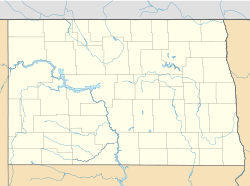Twin Buttes, North Dakota facts for kids
Quick facts for kids
Twin Buttes, North Dakota
|
|
|---|---|
| Country | United States |
| State | North Dakota |
| County | Dunn |
| Elevation | 2,221 ft (677 m) |
| Time zone | UTC-6 (Central (CST)) |
| • Summer (DST) | UTC-5 (CDT) |
| Area code(s) | 701 |
| GNIS feature ID | 1032562 |
Twin Buttes is a special community in Dunn County, North Dakota, United States. It is called an unincorporated community. This means it's a place where people live together, but it doesn't have its own city government like a big town or city.
This community is located on the Fort Berthold Indian Reservation. This reservation is the home of three important Native American tribes. These tribes are the Mandan, Hidatsa, and Arikara. They are often called the Three Affiliated Tribes. Twin Buttes is about 2 kilometers (1.2 miles) south of Lake Sakakawea. It is also about 19 kilometers (12 miles) north-northeast of a town called Halliday.
Contents
Discovering Twin Buttes
Twin Buttes is a unique place in North Dakota. It gets its name from two hills or "buttes" that stand out in the landscape. These buttes are natural landmarks that have been important to the people living there for a very long time.
Where is Twin Buttes Located?
Twin Buttes is found in the western part of North Dakota. It's in Dunn County, which is known for its wide-open spaces and beautiful natural areas. The community is close to Lake Sakakawea, which is a very large reservoir. This lake was formed by the Garrison Dam on the Missouri River.
The Fort Berthold Indian Reservation
Twin Buttes is part of the Fort Berthold Indian Reservation. This reservation is a large area of land set aside for the Mandan, Hidatsa, and Arikara tribes. These tribes have lived in this region for hundreds of years. They have a rich history and culture.
- The Mandan, Hidatsa, and Arikara tribes are known for their strong traditions.
- They have unique languages, stories, and ways of life.
- The reservation helps them keep their culture alive and govern themselves.
The Three Affiliated Tribes
The Mandan, Hidatsa, and Arikara tribes work together as the Three Affiliated Tribes. They share a common history and many cultural practices. They have a tribal government that makes decisions for their communities. This government helps manage the reservation and its resources.
- The tribes have their own schools and health services.
- They work to protect their land and traditions.
- Many people in Twin Buttes are members of these tribes.
Life in Twin Buttes
Life in Twin Buttes is closely connected to the land and the traditions of the Three Affiliated Tribes. The community is small, which means people often know each other well. It's a place where community spirit is strong.
Natural Surroundings
The area around Twin Buttes is very scenic. It has rolling hills, open plains, and is close to the waters of Lake Sakakawea. This natural beauty offers many opportunities for outdoor activities.
- The landscape is home to various types of wildlife.
- The lake is popular for fishing and boating.
- The buttes themselves offer great views of the surrounding area.
Community and Culture
The culture of the Mandan, Hidatsa, and Arikara tribes is a big part of life in Twin Buttes. Traditional ceremonies, dances, and storytelling are important. These activities help pass down knowledge and values from older generations to younger ones.
- Learning about tribal history is a key part of education.
- Community events often celebrate tribal heritage.
- The languages of the tribes are also very important.
History of the Area
The history of Twin Buttes and the Fort Berthold Reservation is long and important. The tribes have lived in this region for centuries. They adapted to the environment and developed unique ways of life.
Early Tribal Life
Before European settlers arrived, the Mandan, Hidatsa, and Arikara tribes lived by farming, hunting, and trading. They built villages along the Missouri River. These villages were often large and well-organized.
- They grew crops like corn, beans, and squash.
- Bison hunting was also a major part of their lives.
- They traded goods with other tribes across North America.
Formation of the Reservation
The Fort Berthold Indian Reservation was established over time. It was created to provide a homeland for the Mandan, Hidatsa, and Arikara tribes. The reservation's boundaries have changed throughout history.
Impact of Lake Sakakawea
The creation of Lake Sakakawea in the mid-20th century had a big impact on the reservation. The damming of the Missouri River flooded many tribal lands. This included homes, farms, and sacred sites. Many people had to move to new areas, including places like Twin Buttes.
- The lake is now a major feature of the landscape.
- It provides water and recreation but also changed tribal life.
- The tribes continue to adapt and thrive despite these changes.
Looking to the Future
Twin Buttes and the Three Affiliated Tribes are always working towards a bright future. They focus on education, economic development, and preserving their culture. Young people in the community play a big role in shaping what comes next.
- New projects aim to create jobs and opportunities.
- Efforts are made to teach tribal languages to children.
- The community works to balance modern life with ancient traditions.



